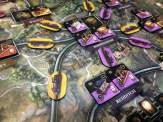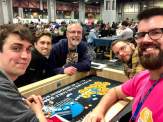One of the things that most competitive and many cooperative games have in common is some sort of turn order. You go first, then comes Bob and then it’s my turn. Turn order might change throughout the game, but there is always someone whose turn it is. The more players there are, the more of an issue it can be, because the longer you have to wait for the round to come back to you. Yet, there is an interesting set of games where everyone plays at the same time, which I want to look at in this article.
Listen to the Audio Version
Intro Music: Bomber (Sting) by Riot (https://www.
Polar Christmas by Sascha Ende
Free download: https://filmmusic.
License (CC BY 4.0): https://filmmusic.
While modern games have often eased the pain of turn order by keeping everyone invested in what’s going on at the table at all times, there is no getting away from the fact that with larger player counts, a round just takes longer. In turn, overall playing time is longer as well. Sure, in a well-designed game, you can make good use of the downtime and plan what you want to do next. So when it’s your turn again, you can immediately carry out your plan, therefore speeding up the round. However, if there is someone at the table who just takes ages to finish their turn, maybe because they are sitting there paralysed by the multitude of options they have, you might easily forget what you planned when the round does finally come back to you.
Compare that to games where everyone takes their turn all at the same time. The length of the turn is decided by the slowest player. There are even games where everyone takes multiple turns at the same time, where you play a full round in parallel before you have to wait for everyone to finish and before you can start the next round. These games feel a lot quicker and you can focus on your plan and your strategy.
Massively Parallel Rounds
The most famous example I can think of for a game where you play a full round in parallel, without having to wait for others to finish their turn, is, of course, Quacks of Quedlinburg. It’s a game where everyone plays “together”, even though it’s competitive. There’s no waiting for others until the end of the round. You can spend a good few minutes drawing ingredients, weighing up the odds of exploding and you can even change your mind at the last minute and take more tokens out of the bag. The round only ends when everyone has finally decided to stop.
It seems crazy that there is no need for turn order. It’s even more crazy to think that you can play a whole round in parallel. Playing the game feels quite leisurely, even though every round is a lot quicker than if you had turn order. The game seems like a real contradiction, but it works beautifully.
A game in a similar vein is the recent print-and-play Dragon vs Kingdom. Instead of everyone playing a whole round in parallel, players take two actions all at the same time on their turn. It slows the game down slightly, but makes sense for this game. I suppose you could have designed it in such a way that everyone can take three or even four actions, but as it is, it still works.
The difference here is that you pass your player sheet to the person on your left. It’s a lovely surprise to see what the previous player decided to do in their turn and then make a decision about where you go from there. There aren’t really any plans you can make in advance. You’re always responding to what went before.

Single Parallel Turns
Another game that is very famous for being parallel play is 7 Wonders, but here everyone takes only a single action. Yet, the parallel play works so well that it plays as quickly with the full quota of seven players as it does with two. 7 Wonders really shows that without turn order, a game can play really quickly even with a lot of people. In theory, even if you shuffled the cards of two copies of 7 Wonders together and played it with 14 players it would still be as quick.
Between Two Castles of Mad King Ludwig is another game that goes up to seven players and plays equally quick at the maximum player count as it does at the minimum, just as 7 Wonders does. While it’s not quite as fully a parallel play game, because you need to talk to your neighbours about where to place your tiles, it does still flow very quickly and the player count doesn’t affect game length, showing yet again how turn order can slow gameplay down.
A slight twist to parallel play can be found in Flamme Rouge. While everyone does choose their cards to play all at the same time, meaning this game doesn’t have any turn order, the actual action is when the cards are revealed in the order in which the riders are on the track. So I wouldn’t necessarily say this game has parallel play. In fact, there is a clear turn order for when the cards are flipped over and the riders are moved forward.
Yet, Flamme Rouge still plays relatively quickly. You can very much focus on your turn and which two cards you’re going to select. There is no waiting for others to make their choices before you make yours.
What About You?
I really like games where everyone plays at the same time. It does make games feel a lot quicker, even if they sometimes can be longer games. Now I want to know what you think about games like the ones I talked about. Have you played any of the games I mentioned? What did you think? Do you like parallel play? Are there any other games that fall within the same category that you have come across? As always, please share your thoughts and experiences in the comments below. I’d love to hear what other games there are that don’t have turn order.
Keeping the blog running takes time and resources. So if you can chip in, that would be amazing.
Useful Links
- Quacks of Quedlinburg review: https://tabletopgamesblog.
com/ 2020/ 06/ 06/ the-quacks-of-quedlinburg-saturday-review/ - Dragon vs Kingdom review: https://tabletopgamesblog.
com/ 2024/ 10/ 12/ dragon-vs-kingdom-saturday-review/ - 7 Wonders: https://www.
rprod. com/ index. php/ en/ games/ 7-wonders - 7 Wonders Duel: https://www.
rprod. com/ index. php/ en/ games/ 7-wonders-duel - Between Two Castles of Mad King Ludwig review: https://tabletopgamesblog.
com/ 2020/ 02/ 15/ between-two-castles-of-mad-king-ludwig-saturday-review/ - Flamme Rouge review: https://tabletopgamesblog.
com/ 2024/ 07/ 13/ flamme-rouge-saturday-review/
Audio Version
Intro Music: Bomber (Sting) by Riot (https://www.
Polar Christmas by Sascha Ende
Free download: https://filmmusic.
License (CC BY 4.0): https://filmmusic.
Playlist
These are the songs I listened to while I was writing this topic discussion article:






